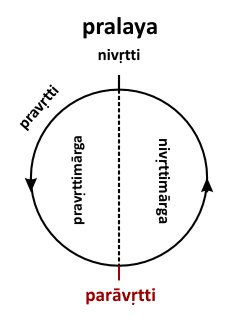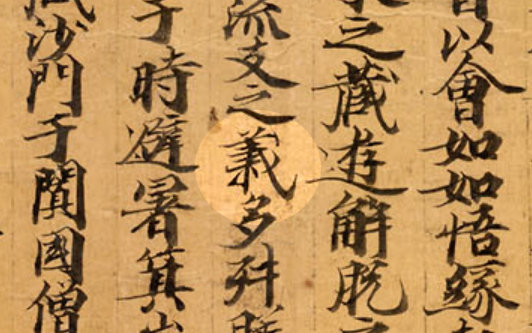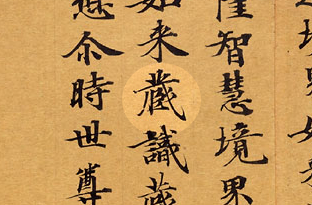The Saṃdhi-nirmocana-sūtra is regarded as the primary source of the Yogācāra teachings given in the words of the Buddha. The ālaya-vijñāna (“foundational consciousness,” or “storehouse consciousness”) is described in its chapter 5 (Tibetan translation) or chapter 3 (Chinese translation). This prose chapter concludes with a verse spoken by the Buddha to highlight some important aspects of the ālaya-vijñāna. In this verse, the ālaya-vijñāna is referred to as the ādāna-vijñāna, the “appropriating consciousness.” This refers to its role of “appropriating” or “taking” a body at the time of birth.
The Saṃdhi-nirmocana-sūtra remains lost in the original Sanskrit, and is now available only in its Chinese and Tibetan translations. Its verse on the ālaya-vijñāna or ādāna-vijñāna has been quoted in a number of Yogācāra texts, also now mostly available only in their Chinese and Tibetan translations. The original Sanskrit of this verse was first recovered as quoted in Sthiramati’s commentary on Vasubandhu’s Vijñapti-mātratā-siddhi Triṃśikā, verse 15, by way of Sylvain Lévi’s pioneering 1925 Sanskrit edition of the Vijñaptimātratāsiddhi. Only long afterwards would we learn that Lévi had silently “corrected” the readings found in the Sanskrit manuscript he used. The manuscript readings turned out to be correct except for one, bālā. Lévi’s “corrections” only added new errors. Lévi gave this verse as follows (p. 34, here transliterated from his devanāgarī script):
ādānavijñānagabhīrasūkṣmo ogho yathā vartati sarvabījo |
bālā eṣāmapi na prakāśite mohaiva ātmā parikalpayeyuḥ ||
Not long after this was published Louis de la Vallée Poussin, recognizing the problems with the portion “bālā eṣām api na prakāśite mohaiva,” emended it on the basis of its Tibetan translation (and a Sanskrit parallel in the Mahāvastu for mā haiva). Poussin gave his emended version in his 1928 French translation, Vijñaptimātratāsiddhi: La Siddhi de Hiuan-tsang, as follows (vol. 1, p. 173):
ādānavijñāna gabhīrasūkṣmo
ogho yathā vartati sarvabījo |
bālāna eṣo mayi na prakāśi(to)
mā haiva ātmā parikalpayeyuḥ ||
In this emended form (accepting prakāśi) it was given by Étienne Lamotte in his 1935 French translation of the Saṃdhinirmocana Sūtra (p. 58), in his 1936 French translation of the Karmasiddhiprakaraṇa (p. 247), and in his 1938 French translation of the Mahāyānasaṃgraha (p. 14).
In 1989 reproductions of the original Sanskrit manuscript as well as the transcript of it used by Sylvain Lévi for his 1925 edition became available inThree Works of Vasubandhu in Sanskrit Manuscript., edited by Katsumi Mimaki, Musachi Tachikawa and Akira Yuyama. These showed that bālā is indeed in the manuscript and its transcript, but that Lévi had “corrected” their “eṣo mayi na prakāśito mā haiva” to “eṣām api na prakāśite mohaiva.” These confirmed Poussin’s emendations, except for bālāna.
Hartmut Buescher in his 2007 critical edition of Sthiramati’s Triṃśikāvijñaptibhāṣya (p. 104) gave the correct readings from the manuscript, and accepted Poussin’s emendation bālāna, as well as prakāśi rather than the manuscript’s prakāśito. He explained in footnotes that for metrical and grammatical reasons he adopted bālāna, a genitive plural form in Buddhist Hybrid Sanskrit (see Edgerton’s Grammar, para. 8.117 ff.), rather than the manuscript’s bālā (regarding his comment that bālā looks more like bānā in the manuscript, to me it looks like bālā). He also explained that he adopted the aorist verb prakāśi (Edgerton’s Grammar, para. 32.47 ff.), since the manuscript’s prakāśito gives one too many syllables for the verse. He gives this verse as follows, essentially the same as Poussin’s emended version:
ādānavijñāna gabhīrasūkṣmo ogho yathā vartati sarvabījo |
bālāna eṣo mayi na prakāśi mā haiva ātmā parikalpayeyur [||] iti |
A second source for the original Sanskrit of this verse became available in 2013. It is quoted in Sthiramati’s Pañcaskandhakavibhāṣā, edited by Jowita Kramer, 2 volumes, and published in the important new series, Sanskrit Texts from the Tibetan Autonomous Region. In volume 2, the diplomatic edition, essentially a transcript of the manuscript, this verse appears as follows (p. 85):
ādānavijñāna gambhīrasūkṣmo ogho yathā varttati sarvabījo |
bālāna eṣo mayi na prakāśito mā haiva ātmā parikalpayeyuḥ ||
As we see, Poussin’s emendation of bālā to bālāna is confirmed. The proposed emendation prakāśi is not supported by this manuscript. Like the manuscript of Sthiramati’s other text, this manuscript reads prakāśito, despite being one syllable more than the meter should have. In volume 1, the critical edition, this verse appears as follows (p. 94):
ādānavijñāna gambhīrasūkṣmo ogho yathā vartati sarvabījaḥ |
bālāna eṣo mayi na prakāśito mā haiva ātmā parikalpayeyuḥ ||
The editor had little choice but to retain prakāśito. This verse may be translated as follows:
“The appropriating consciousness, deep and subtle, flows with all its seeds like a current. This was not taught by me to the immature, so that they would not imagine it as a self.”
Category: Alaya, Samdhinirmocanasutra, Yogacara | No comments yet


